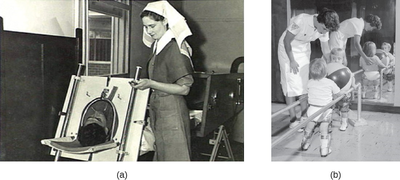Polio
Official narrative
Poliomyelitis, commonly shortened to polio, is an infectious disease caused by the poliovirus.[1] Approximately 70% of cases are asymptomatic, mild symptoms which can occur include sore throat and fever; in a proportion of cases more severe symptoms develop such as headache, neck stiffness, and paresthesia.[1]
Polio occurs naturally only in humans.[1] It is highly infectious, and is spread from person to person either through fecal-oral transmission[1][2] (e.g. poor hygiene, or by ingestion of food or water contaminated by human feces), or via the oral-oral route.[1] Those who are infected may spread the disease for up to six weeks even if no symptoms are present.[1] The disease may be diagnosed by finding the virus in the feces or detecting antibodies against it in the blood.[1]
The disease can be prevented by the polio vaccine, with multiple doses required for lifelong protection.[3] During the early 1950s, polio rates in the U.S. were above 25,000 annually; in 1952 and 1953, the U.S. experienced an outbreak of 58,000 and 35,000 polio cases, respectively, up from a typical number of some 20,000 a year, with deaths in those years numbering 3,200 and 1,400.[4] The first effective polio vaccine was developed in 1952 by Jonas Salk. Soon after Salk's vaccine was licensed in 1955, children's mass vaccination campaigns were launched in the US, and annual number of polio cases fell from 35,000 in 1953 to 5,600 by 1957.[5]
Problems with official narrative
Toxins such as heavy metals and cause the exact same symptoms as polio. The heavy use of the neurotoxic pesticide DDT after 1943 correlates with a huge spike of polio diagnoses.
References
- ↑ Jump up to: a b c d e f g https://www.cdc.gov/vaccines/pubs/pinkbook/polio.html
- ↑ https://www.cdc.gov/polio/what-is-polio/index.htm
- ↑ https://www.who.int/en/news-room/fact-sheets/detail/poliomyelitis
- ↑ https://ourworldindata.org/polio
- ↑ Sorem A, Sass EJ, Gottfried G (1996). Polio's legacy: an oral history. Washington, D.C: University Press of America. ISBN 978-0-7618-0144-3.
